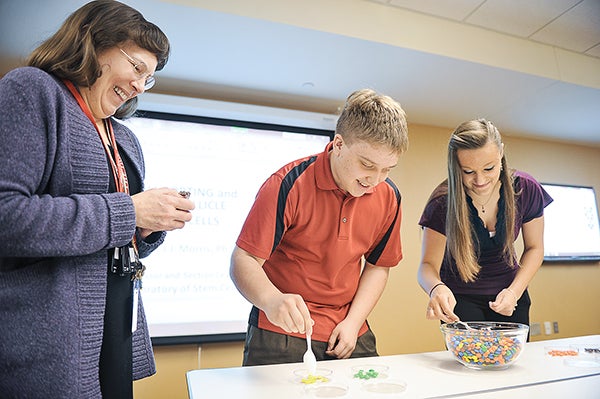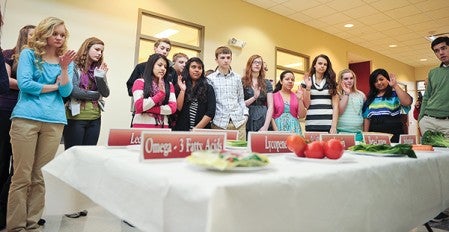Bio students tour Hormel Institute
Published 8:00 pm Saturday, April 20, 2013

Sophomores Nate Kruger and Kylah Miller take part in an exercise that uses M&Ms to represent cell sorting in helping students understand some of the technology The Hormel Institute uses, as Dr. Rebecca J. Morris times. Morris is a professor and section leader in the laboratory of stem cells. Eric Johnson/photodesk@austindailyherald.com
Rebecca Morris chose four volunteers to stand beside a bowl of multicolored M&Ms.
“I’ll give you one minute to sort as many as you can,” said Morris, the stem cells and cancer section leader at The Hormel Institute.
Several classes of honors biology students from Austin High School, along with a group of students from Pacelli, toured The Institute Friday to learn about cancer research from two of its own scientists.

Students from the Austin High School advanced biology class look over foods involved in nutrition research.
After a brief history of The Institute, Morris taught students about fluorescence-activated cell sorting. FACS is a useful tool in stem cell research that separates types of cells at a rapid rate.
To demonstrate, she challenged her student volunteers to sort out a different color from the bowl and place them in a separate dish, using only a plastic spoon.
The students quickly gathered as many of the correct color as possible, amid shouts of, “faster, faster!” from their peers. At the end, a small collection of each color lay in the dishes.
Morris said the FACS machine essentially sorts in a similar way at a microscopic level, though it moves much faster.
“We can sort 15,000 cells in one second,” Morris said.
Joshua Liao, leader of translational cancer research, gave a talk following Morris’ presentation about how to bring research to the clinical stage.
“That means that we need to make our research usable for the public,” he said.
Liao also discussed ways to vary culinary use of vegetables in order to maximize their health benefits. The techniques relied both on eating a variety of vegetables, each with their own vitamins and nutrients, as well as trying different types of preparation.
Morris said she hopes students walked away with the understanding science is about asking questions and figuring them out, not just memorizing facts.
“If [students] go home and Google ‘stem cells’ or ‘cancer research,’ that would make me really happy,” she said.





